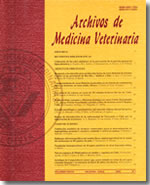A survey on the prevalence of foot lesions in sheep from 25 small holdings in the province of Valdivia, Chile
Main Article Content
Abstract
In order to determine the prevalence and risk factors of foot lesions, 478 sheep from 25 small holdings of six different counties in the province of Valdivia were examined between May and July, 1998. In addition, information about nutrition and management of the flocks in the farms studied was gathered.
The farms were selected by convenience, according to their geographical location, number of sheep and willingness of the owners to participate. The examination of the sheep was carried out individually. Each hoof of all four feet was examined and if necessary trimmed. All the lesions present were recorded in an individual recording sheet. The age, body condition score and genotype were also recorded. The data obtained were entered into the EPI-INFO 5.0 database and exported to EXCEL 5.0 for further analysis. Differences between proportions were investigated using Yate`s corrected c2 tests and odds ratios with a 95% of confident intervals.
The average size of the flocks was 19 ewes. Nutrition of the flocks was based on grazing natural pastures without supplementation. A 68% of the ewes had a body condition score of 2.5 or higher. In relationship to the genotype 42.5% were Romney Marsh, 43% were crossbred and the others were Suffolk Down, Hampshire Down and Austral.
Ninety five percent of all ewes examined had at least one lesion in one of their feet and 69% of all ewes had more than one lesion. The prevalence of the different lesions diagnosed were: overgrown horn 90%; horn separation 62.3% white line diffuse lesions 53%; white line focal lesions 37.4%; slippered feet 7.3%; overgrown heels 6.9%; deformed horn 4.6%; broken horn 4.0%; double sole 1.7%; foreign bodies 1.5% and interdigital fibroma, 0.4%.
The age was a significant risk factor for the presentation of lesions (p<0.039) especially for horn separation (p<0.00002), white line diffuse lesions (p<0.005) and white line focal lesions (p<0.0008). Ewes older than 4.5 years old had the greatest risk of presenting horn overgrown (p<0.003). A body condition score of 2 or less was found associated to a lower prevalence of horn separation (p<0.027).
Trimming of the hooves is a management measure that was not routinely carried out in the flocks examined and it could have contributed to control many of the lesions found in this study.

